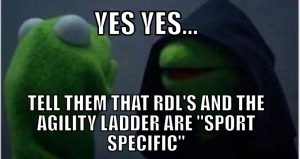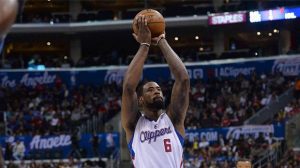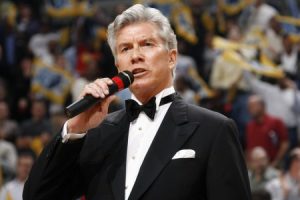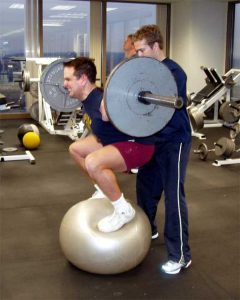Just What Is “Sport Specific” Training Anyways?
You hear it referred to on ESPN, discussed by Little League dads across the country, and questioned by physical prep coaches in every sport. Like many of these fitness buzz terms (core, cardio) there’s more sizzle than steak, and what gets sold as “sport specific” may not be specific in the slightest. I have a hired gun joining me in today’s post, my good friend and exceptional coach, Chris Gray, of Ignition APG in Cincinnati, Ohio. We will share our experiences with this term, what we think it means, and how it applies to athletes at different levels.
So, is anyone gonna look deeper at this term or what?
My thoughts first. The catalyst for me in regard to this conversation stems from my clientele, which is mostly high school athletes. These athletes generally possess a low training base, are in need of a lot of general physical preparation and basic movement skills. It is this same client base that I receive requests for sport specific training from. Cue nails on a chalkboard. Also enter that classic angel/devil on the shoulder dynamic first seen in the Shepard of Hermas.

You say little Johnny needs sport specific? Here we go again.

This happens way more than it should.
Well, lifting ain’t exactly specific to any one sport. Neither is running. There is no such thing as a basketball squat, a softball sprint, or a football crunch. I think for clarity’s sake we need to do a better job of defining what these things are, and how they can help the athletes we train.
First and foremost, a solid base of general athletic prep is essential in keeping athletes healthy, happy, and progressing positively. Squatting, lunging, flexing, extending, twisting, pushing, pulling, rotating, anti-rotating, running, stopping, cutting, and jumping are just SOME of the basic things an athlete needs to do well. The athletes that do them well seem to have an easier time picking up multiple sports skills. Bill Gates would tell you in computer terms-the general physical hardware enhances the acquisition of sport specific software.

Hardware helps software folks.
I’ve referenced this study in a previous blog but it bares repeating here. David Epstein, author of The Sports Gene, examined a study done in 1978 by the German Tennis Federation on the most talented 8 to 12 year old tennis players. Epstein writes, “Of 106 kids, 98 eventually made it to the professional level, 10 rose to the top 100 players in the world, and a few climbed all the way to the top 10. Each year for five years, the scientists gauged the children first on tennis specific skills and then on measures of general athleticism… The tests of general athleticism- for example, a thirty-meter sprint and start-and-stop agility drills- influenced which children would acquire the tennis-specific skills most rapidly.” He concludes, “Over the five years of the study, the kids who were better all-around athletes were better at acquiring tennis-specific skills… superior hardware was speeding the download of tennis-skill software.”
For me, that’s a smoking gun that is hard to deny. The greater general physical preparation (GPP) helps supplement the specialized physical preparation (SPP). On what scale? That’s hard to determine. Like most things, this is context based and dependent on the ability level of the athlete in question. The higher the level, the less time should be focused on the GPP side of the coin. Most elite level athletes have already mastered the basics and need more specialized measures to help enhance performance.
Here’s a real world example. Squatting alone isn’t going to fix DeAndre Jordan’s broken free throws. He’s 6’11, 260 pounds with a 30.5″ vertical. Very big, very strong, moves well, and jumps reasonably high. Another inch or two on his vertical might aid in blocks or rebounds, but it won’t dramatically change his ability to shoot the ball. For that, more SPP is warranted. (Or a hypnotist, or a voodoo shaman. The guy has a 43% career free throw rate. Who even knows at this point.)

Squatting isn’t fixing this form.
That isn’t to say professional athletes can’t benefit from GPP also. A well balanced physical preparation program can clean up motor patterns, and get the top guys moving and feeling better, which in turn helps in the psychological component of sports performance.
Here is my best answer to what true sport specific training is, beyond you know, just playing your sport. For starters, you should read Anatoliy Bondarchuk’s Transfer of Training in Sports. Widely thought of as the greatest Olympic coach ever, Bondarchuk’s seminal work contains definitions of various exercises and how they fit in the general to specific continuum.
From general preparation to specialized developmental exercises. This book has it all.
Mic drop, over to Coach Gray.
Chris Gray is a Senior Performance Specialist at Ignition APG in Cincinnati, Ohio. He has worked at 5 different universities at the collegiate level, as well as spent time working in the NFL, and with high schools. He can be reached at c.gray@ignitionapg.com or you can follow him on instagram @wgray70, twitter @CoachGray70 His thoughts are as follows:
MAKE SOME NOISE… and in the famous words of DJ Kool, “Let me clear my throat.”
GPP versus SPP
This has the makings of an epic Rocky fight that has been building for a number of years. It is a constant debate among coaches, parents, administrators, and professionals across all levels. Cue up some epic GPP and Sport Specific training montages.

Rocky went for some long strolls on the beach. Must be some serious high level boxing specific training right there.
Conversations usually start out like this…
“Coach, I want to do some more sport specific training.”
No matter what corner of the “sports performance” field you find yourself in, there is no doubt in my mind you have heard these phrases or used them yourself. Having coached at the collegiate level, trained NFL athletes, and now overseeing countless number of high school athletes, my response to this statement is always changing.
In the strength and conditioning world this has become a growing issue of debate.
GPP

Let’s get ready to rumble
“Fighting out of the blue corner” (in my best Michael Buffer voice) you will have your hard core purists that will argue tooth and nail that no one is in here having Tommy do a single arm DB overhead press while dribbling a basketball in the other. We are strength training. Working on aerobic capacity. TSpine. Flexibility. Original Strength (OS). Jumping. Landing. Hell, you get the point.
The movement purists will all cheer together, “MOVE WELL, MOVE OFTEN, MOVE WEIGHT.”
At the end of the day we are incorporating some progressive training principles while loading movements. That’s it. The belief is that we are training the holistic athlete and that we must treat them as an athlete before we take into account sport specificity.
“MOVE WELL, MOVE OFTEN, MOVE WEIGHT.”
If you can’t execute this order effectively you are putting the athlete in a car with bad breaks, with an alignment that’s slightly off, with a gas tank that’s half full. Sure you can go places, but the reality is that while this issue might not come out in the wash immediately, you are not setting this athlete up for the long term. Their return on investment will never be as great as it could be. This is ESPECIALLY IMPORTANT for athletes with a low “training age” (middle and high schoolers).
It’s like the old Stanford University “Marshmallow Test” (about delayed gratification). Would you rather have one marshmallow now or two in fifteen minutes? Those kids would stare at the marshmallow, cover their eyes, pull their hair, or even kick the desk. Frankly, if you jump into loading an athlete before they are ready, you will have the purists pulling their hair out and stomping their feet. But the reality is, in every sense of the analogy, two marshmallows are always better than one… even with the wait.

Delayed gratification is a struggle when you want it now.
For ALL of the athletes I work with, GPP is always part of the program- professionals to middle and high school. This includes those fundamental movements (hinge, push, pull, squat, carry and rotate) that we do, not just in our athletic endeavors, but also IN LIFE. Sure we all want Sally to be able to turn on a 60 mph rise ball sending it 240 feet to dead center, but helping her move better in life is equally important. The way I think about it with my younger athletes is like this.
HGTV
We all watch the channel and the shows to see what Tiffany does with the drapes or the carpet in the living room. Did Greg really put a big screen TV in his “man cave”? I cant believe they went with the tile back splash. So chic.

Tarek has to make sure the foundation is solid before Christina can spiff the place up
We all want to design rooms and floors and rush through the build. If your foundation is crap, chances are no amount of paint, wallpaper, or granite countertops can take your eyes away from the massive crack in your floor. The same goes for younger athletes. It’s important to spend time building the foundation before you start adding too much sport specificity.
SPP

oh my
Out of the “red corner” come the “trailblazers” of the modern fitness trend that is “Sport Specific Training”. These new guru’s scoff at Yessis, Boyle, Cressey and others, knowing that pushing the athlete in the deep end with an anchor tied to their feet and without those coveted “Nemo” floaties will force them to learn to swim immediately.
Okay Okay. This last part is a bit far fetched.
“If you balance on this thingy, while patting your head and rubbing your belly, muscle hypertrophy will be through the roof”)
The reality is what? Sport specific training is TRAINING SKILL SETS FOR THAT SPORT. That’s how I’ve always viewed it. It’s the running, jumping, swinging, striking, catching, throwing portion.
Can you execute specific lifts, mirror movements that are specific to that sport? SURE. What about speed and agility drills. HECK YES. With all athletes I work with, we work on some skills or movement patterns that are particular to that individual sport. With the tennis folk, chronic issues revolve around the wrist, elbow shoulder (serving and swinging) as well as the ankle, knee, hip (3 planes of movement acceleration and deceleration.) Do I spend time strengthening muscles associated with those areas? Yup. Do I spend time training and working on ROM as to increase ligament and joint integrity to those areas? Yup. Do we work hand eye coordination? Yup. All of these things will add value to the athlete and the demands on their sport.
The Verdict?
With all of this being said… I want to REFRAME the request everyone makes from….
“Coach, I want to do some more sport specific training”
to…
“Coach, how much sport specific training is right for me?”
For my NFL vets that I work with, their training age is so much greater than that of a high school freshman. They have much more time under a bar and working on fundamental movements where now their focus needs to be a bit more of applicable sport specific training. They need the granite countertop in the kitchen, the stainless steel appliances and hardwood floors. Their house has been built over time. While they still upkeep the foundation we turn the focus to more sport specific.
In the end it comes down to how well the foundation is built and that dictates how much sport specific training is needed, athlete by athlete.


